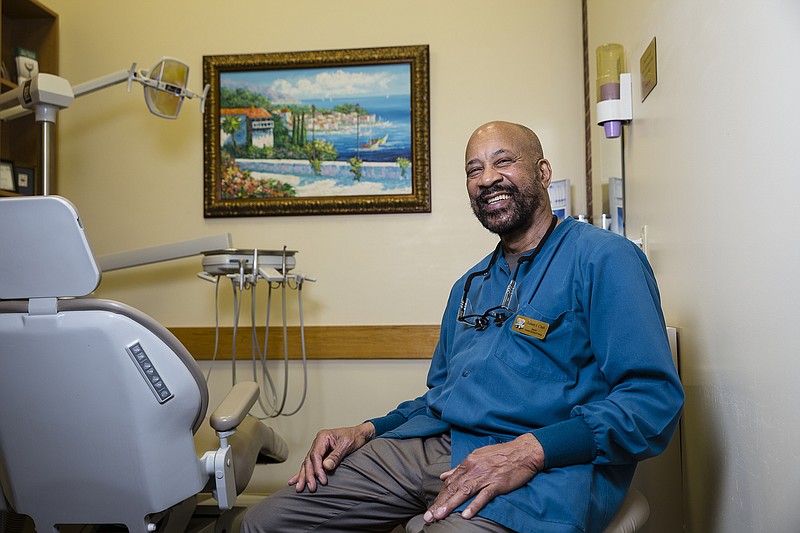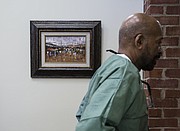If you head to Dr. Robert Clark's office to get your teeth cleaned, you can be sure of one thing: You'll have original art to look at. That's not to say Clark's East Brainerd practice won't handle your dental needs. To the contrary, being there might even make you feel better about getting your molar drilled.
"When you walk down a hall or into a room, there's something there that makes you feel more positive," says Clark, who estimates he's been collecting original works for 40 years. He started displaying pieces in his offices in 2009 and estimates 65 pieces are up now. The art - from paintings to handmade dolls to quilts - all has meaning to Clark.
"It's from local artists or artists that I met during my lifetime, and I have family members who are artists," he says. His son paints, for example. "I try to support the local artists who are striving to become known here in the Chattanooga," Clark says.
For some businesses, though, owning an art collection isn't economically feasible – or easy to put together and figure out how to showcase. What's more, some businesses like the idea of decorating with local and original art but don't want static collections. To that end, Chattanooga organizations such as the Association for Visual Arts and JUMP-
ST/ART have created niches to help local businesses.
AVA's program started under a different name, as a corporate-lending program, in 2008 and ended in 2010, recalls former curator Lauren Goforth, now with the San Francisco Film Society. The AVA started it back up as Art Loan in 2015.
"The thought process behind bringing it back was that it was really a win-win-win: for AVA, local artists and area businesses," Goforth says.
These days, the nonprofit organization curates and installs works of art for several area businesses, including at Chattanooga's largest law firm, Miller & Martin, and the city's biggest accounting firm, Elliott Davis Decosimo. Loan rotations usually last about six months.
"We are here to support our local artists," says Ric Morris, AVA's executive directer. The loan program is another way for AVA to fulfill its mission of connecting art and community, Goforth adds.
Artists earn $50 per piece, each month a piece is on loan. And if a piece sells, the artist keeps 70 percent of the price tag, while AVA gets 30 percent.
"Even if it's not selling, it's not sitting in their warehouse, their basement, not being seen, not even having the potential of being sold," Morris contends.
Businesses, on the other hand, "can have a changing environment by having new pieces of art," Morris says. "Indirectly, they are supporting artists."
AVA clients can request certain artists, but most businesses count on the organization's expertise.
"We kind of trusted their judgement," says Nick Decosimo, managing shareholder for Elliott Davis Decosimo's Chattanooga office.
That's a credit to AVA's curators, including Goforth and current curator Kreneshia Whiteside.
Elliott Davis Decosimo relied on both AVA and JUMPST/ART to beautify its walls. AVA has currently outfitted the accounting firm's small first-floor reception area with eight works of art, ranging from a large abstract painting in bold reds to two small earth-toned mixed media and collage pieces by local artist Michael Holsomback. The exhibit costs the firm about $1,700 for six months, including curation and installation, Decosimo says. "The fees for that are just very reasonable." This is the firm's second installment through AVA.
"We've always had art in the office" Decosimo says. "It makes the environment a lot nicer."
His mother is a painter. And he has original art in his personal office: two pieces by his former sister-in-law and one by his brother.
Miller & Martin tapped AVA about two years ago, shortly after it renovated the top floor of its office building.
"It allows us to immediately fill up the entire space," says Evan Allison, an attorney with the law firm. "It's hard to budget for a one-time purchase that fills an entire floor."
The fact that the art changes every six months is a bonus. "I think our employees and clients like to see something different," Allison says.
The pieces, which range in medium, are sparingly placed throughout the neutral-toned space, often below recessed lighting. The firm pays about $2,250 every six months for AVA's service and displaying the pieces, Allison says. The current display includes pieces by Greg Haynes and Ellen Franklin.
Chambliss, Bahner & Stophel has counted on JUMPST/ART for more than four years to spruce up its reception floor, which hosts clients and public events. The floor has roughly 30 to 38 pieces on display at a given time, according to JUMPST/ART owner Gail Rich. Her company's model is different from AVA's Art Loan program: Artists are compensated only if a piece sells. Rich declined to share her fee structure for artists or the companies she works with.
Rich has a stable of about 20 core artists and another 15 or so on the periphery, she says. She refers to her displays as "galleries" and "shows." "They are designed as such, as they are permanent locations within each corporate office to display and sell art works," Rich says.
Chambliss Bahner & Stophel even has a name for its gallery –-Art Connection - which features Chattanooga talent, including Charlie Newton.
"We saw the gallery as an opportunity to continue our commitment to the community and its cultural development through the establishment of this rotating exhibit," says Aricia C. Gallaher, the law firm's marketing and business development director. "Our art gallery also allows us to update our public space and office environment, all the while keeping up with local trends."
Neither AVA nor JUMPST/ART shared hard numbers on how many pieces each has sold on behalf of artists. Businesses said they don't keep count but noted that several pieces have sold to clients or employees, and some employees have commissioned artists to create new works for them.
The loan program hasn't had any drawbacks, Allison says, a sentiment echoed by others. Nor have the businesses heard any complaints about displaying original art at their sites, even if tastes vary.
"I guess our fear is just that AVA will cancel the program at some time," Allison says, "and we will have bare walls."

